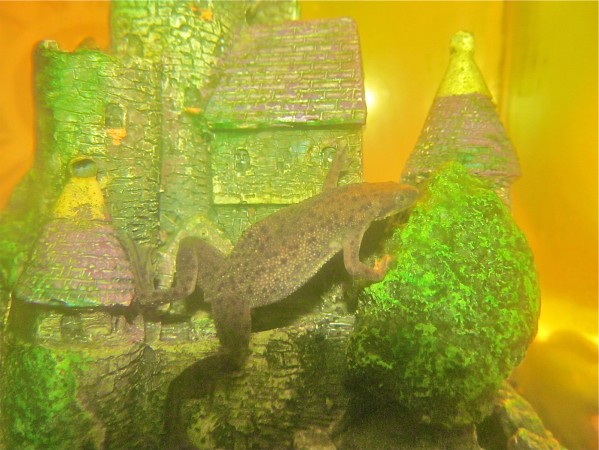5 Things You Need To Know Before Getting An African Dwarf Frog
- Oct 29, 2021
- Rita
- 3548 0 0

Are you thinking of getting a frog as your next aquatic pet? If so, then there are a few things you should be aware of. Frogs aren’t the easiest pets to care for so make sure you’re properly prepared. Read on for more on frog keeping.
5 Things You Should Know Before Getting An Axolotl
Before getting a frog, make sure you know what you're getting yourself into. Let's take a look.
Tank Setup
African dwarf frogs are fully aquatic. This means that they don’t need to leave the water, in fact, your frog will die if left outside of the water for longer than 15 to 20 minutes. The reason for this is dehydration. The skin of an African dwarf frog is not designed to prevent the loss of moisture since this frog permanently submerges itself.
If you want to create an area where your frog can leave the water, make sure to keep the humidity as high as possible to prevent dehydration. You also need to make sure your frogs get a proper day and night cycle. To do this, set your timer to allow the lights in the tank to be on for at least 10 to 12 hours per day. Fortunately, you don’t need to worry about any fancy lighting, a normal aquarium LED light will work just fine.
You will also need a good filtration system to ensure the best quality water, but do make sure to keep the flow to a minimum. These frogs prefer very slow-moving water that allows them to hang around at the surface without moving.
It is best to set up your frog tank with some substrate at the bottom. You can use either sand or gravel to do this as long as the gravel is large enough to not get swallowed by the frog. If you don’t mind the maintenance, consider getting live plants. These frogs do best if kept in a tank with live plants to hide in. The plants will also help to regulate the water parameters to keep your frog healthy.
To keep the water parameters in check and avoid any anaerobic bacterial growth, you can add an airstone to your tank. Just make sure that the pump is isolated from the tank. Frogs don’t like any extra vibrations on the tank and will become stressed if exposed to it for a long time. For this same reason, it’s a good idea to isolate the tank from its stand with styrofoam to dumb down the vibrations caused by the filtration system.
The last thing to consider is your frog’s behavior when setting up your tank. Frogs are prey animals. This means they will get stressed if left exposed. To keep your frog’s stress levels down, provide lots of hiding spots with plants, rocks, driftwood, or other tank decorations.

Ungainly by Renee Grayson
Diet
African dwarf frogs are omnivores. Given the choice, however, they will usually go for meaty treats first. To keep these frogs healthy, it’s best to feed a varied diet that includes meaty treats like bloodworms, pieces of cucumber or peas, and specially formulated pellets.
Sometimes it can be difficult to feed these critters so you might need a bit of patience and some tweezers. Simply grab a piece of food and wave it in front of your frog’s face until it grabs the food.
You can feed both live or frozen food or a variety of both. The most common meaty treats you can consider are mosquito larvae, bloodworms, brine shrimps, krill, and earthworms. If any of your fish spawn, the frog will also hunt the fry.
Feed meaty treats only once a week since they are quite rich. You can feed pellet-based foods as a healthy daily diet varied with some veggies. Make sure to feed just enough food that your frog can easily finish it within 15 minutes of feeding.
Young frogs will need to be fed once a day, but as they mature you can start to feed on alternate days. Adult frogs only need to eat every two days.
Water Parameters
African dwarf frogs can be a bit difficult to maintain. They are very sensitive to chemicals and waste in the water. This means that you’ll need to condition the water properly during every water change and do regular tank maintenance. To make sure your frogs stay healthy, do regular water tests to get an idea of what the water parameters are like.
Weekly 20% water changes should help to keep the water quality pristine, but do make sure to test the water during every water change to make sure no chemicals get into your system.
Frogs need the following parameters to stay healthy:
Temperature: 72-78°F (22-25.5°C)
pH: 6.5-7.8
GH: 5-20
kH: 4-15
NH3-: 0ppm
NO2-: 0ppm
NO3-: <20ppm

By Stuart Halliday - w:en:Quatermass (talk | contribs) - Own work by the original uploader, CC BY 3.0, https://commons.wikimedia.org/w/index.php?curid=57093257
Behavior And Tank Mates
African dwarf frogs are very peaceful creatures that do well in community tanks. As long as you keep your frogs and fish well-fed, you shouldn’t have any problems with aggression. If you’re worried about harassment, make sure that all the fish in your community tank also have peaceful natures.
The best fish to keep with African dwarf frogs are any livebearers (mollies, guppies, etc.), danios, schooling tetras, corydoras, or loaches. You can also keep invertebrates like cherry, bamboo, or ghost shrimps. It’s also possible to keep snails with these wonderful amphibians.
African dwarf frogs can sometimes give their keepers a scare. They sometimes float at the surface of the water without moving with their legs extended. They may appear to be dead when doing this, but don’t worry, it’s quite normal and referred to as the zen position.
Frogs can also be very entertaining aquatic pets. You’ll see them come out mostly at night to dart around the tank. They need to go to the surface to breathe so make sure the surface isn’t covered in dese plant growth.
Due to being prey to many creatures in the wild, they have a need to hide. Make sure there are many caves and plants for them to hide in. They are also very social so make sure to keep them in small communities of 2 to 3 frogs.
Lifespan And Health Problems
African dwarf frogs live can live for around 5 years if properly cared for. Don’t touch your frog if you can avoid it. The skin of frogs carries a lot of bacteria that can be harmful to humans. Salmonella is particularly concerning so rather use a net and wash your hands thoroughly after handling it.
Frogs are also quite sensitive. For this reason, avoid any sharp artificial objects and gravel in your tank. Your frog might end up with lacerations if care isn’t taken.
The most common condition in these frogs is called dropsy. This condition is usually fatal and has a variety of symptoms such as bloating, reduced apatite, listlessness, and more. Dropsy is caused by a variety of conditions including bacterial infections and parasites.
Final Thoughts
Now that you understand what it will take to look after a frog, you can start thinking of where to get one. Make sure to get a healthy specimen and set up your tank at least one month prior to your frog purchase. This will allow the tank to cycle before your frog comes home.
A cycled tank means a happy frog! Happy frog keeping!






About author